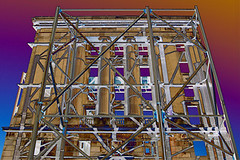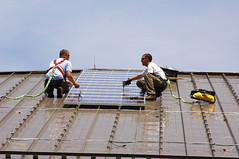Job creation through smart land use & transportation

Posted September 3, 2010 at 2:23PM
The nation’s workforce has an important stake in smart, environmentally sound development and transportation. At a time when unemployment has reached disturbing levels, public policy should take advantage of the job-creation benefits of a robust agenda for smart, sustainable communities. I won’t pretend to know every aspect, but let’s look at three categories:
Public transit
People take for granted that “shovel-ready” highway projects create jobs. But investment in public transportation may be even more effective in generating employment. Yesterday, just in time for Labor Day, the Transportation Equity Network released a report showing that US metro regions that give a high priority to transit “generate more jobs per dollar spent on transportation” than do regions that emphasize highways:
“If [the studied] 20 metropolitan areas shifted 50 percent of their highway funds to transit, they would generate 1,123,674 new transit jobs over a five-year period — for a net gain of 180,150 jobs over five years — without a single dollar of new spending.
If federal spending on transit increased as proposed by Transportation for America and TEN, we estimate it would create 1.3 million jobs over the life of the law, and almost 800,000 more jobs than under present federal transportation law.”
The report was authored by the Public Policy Research Center of the University of Missouri at Saint Louis.
The new report is directionally consistent with an earlier study of investments made under federal stimulus legislation by Smart Growth America. That study found that every billion dollars spent on public transportation under the American Recovery and Reinvestment Act had produced 19,299 job-months through the end of 2009, while every billion dollars spent on highway projects produced only 10,493 job-months. The authors report that public transit dollars are more efficient at job creation than highway dollars because (as paraphrased by Keith Baker on Autopia) “first, less money is spent acquiring land, which means more money is spent actually building something; second, all those buses, trains and subways need people to operate them and maintain the infrastructure; and third, public transit requires a workforce with more diverse skills than highway construction.”
Moreover, the impacts go beyond transit jobs per se: a new study issued by the Michigan Department of Transportation finds that, for every 10 jobs created in the public transit sector, six additional jobs are created in the rest of the economy.
Revitalization
Restoring existing neighborhoods is also a remarkably effective way to create jobs. A study released in March of this year by the National Trust for Historic Preservation and authored by researchers at Rutgers University found that, in 2008 alone, historic rehabilitation created 58,000 new jobs and that, over the 30-year life of the federal historic tax credit, 1.8 million rehab jobs have been created.  The research also found that jobs associated with historic rehabs, mostly concentrated in the construction, manufacturing, service, and retail sectors, require higher skill levels and pay better wages than those generated by new construction. The report further notes that the labor and materials used for historic rehabilitations tend to be hired or purchased locally, so that the benefits accrue to host communities.
The research also found that jobs associated with historic rehabs, mostly concentrated in the construction, manufacturing, service, and retail sectors, require higher skill levels and pay better wages than those generated by new construction. The report further notes that the labor and materials used for historic rehabilitations tend to be hired or purchased locally, so that the benefits accrue to host communities.
The Trust contends that these numbers, impressive as they are, may actually understate the favorable impacts of restoration:
“Left uncounted are the jobs, wages, and taxes generated by the heritage tourism that is attracted by historic sites and districts. Also not factored into this study is the economic impact of the additional rehabilitation work that typically follows the initial investment as confidence in the area's future rises.”
Moreover, the state of Maryland’s planning office reports that, according to a recent study by the Abell Foundation, every dollar of rehabilitation tax credit generates $8.53 in economic activity and each million dollars is “estimated to put about 73 skilled trades people to work on labor-intensive projects in the construction industry.” Recognizing the economic benefits of revitalization, the Maryland Board of Public Works recently authorized the first phase of a $1.5 billion public/private partnership to invigorate a key area of downtown Baltimore, bringing thousands of new jobs and millions in new revenues to the state.
Green buildings
Finally, the US Green Building Council, relying on a thorough meta-analysis by Booz Allen Hamilton last year, predicts dramatically robust employment for the green building sector, including the creation of 7.9 million jobs and the contribution of $554 billion to the US gross domestic product between 2009 and 2013. While that is surely optimistic given the current sluggishness of the construction industry, Booz Allen also found that, from 2000 through 2008, green building contributed 2.4 million jobs and $123 billion in wages to the US economy. In a national survey of architects, builders, remodelers, and contractors, EcoHome magazine found that a strong majority believed that “green building will lead all other trends when the housing industry re-emerges.”
For perspective on additional ways in which land use affects working families and how smart growth can help, see the web site of Good Jobs First, a national policy resource center for grassroots groups and public officials.
Move your cursor over the images for credit information.



